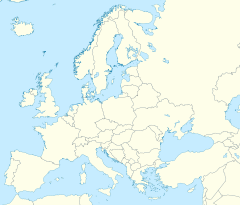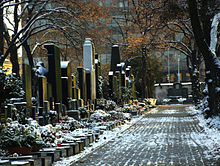- Olšany Cemetery
-
Olšany Cemetery 
Graves of soldiers from Commonwealth, Olšany Cemetery.Details Year established 1680 Country Czech Republic Location Prague Type Public Number of graves 65,000 Olšany Cemetery (Olšanské hřbitovy in Czech) is the largest graveyard in Prague, Czech Republic, once having as many as two million burials. The cemetery is particularly noted for its many remarkable art nouveau monuments.[1]
Contents
History
The Olšany Cemetery was created in 1680 to accommodate plague victims who died en masse in Prague and needed to be buried quickly. In 1787, when the plague again struck the city, Emperor Joseph II banned the burial of bodies within Prague city limits and Olšany Cemetery was declared the central graveyard for hygiene purposes.[2]
Olšany necropolis consists of twelve cemeteries. There are two ceremonial halls assigned to bid farewell to the deceased; the newer one is located in a building of the former of Prague's first crematoriums. New to the scene is the "Olšany Cemetery Learning Trail" which is so far mapping the history of three of the oldest sections and also sketches the life stories of some celebrities buried here. Prague's Olšany cemetery excels in its picturesque style and its tranquil nooks, surpassing even Malostranský cemetery and Slavín, and is the biggest necropolis in the Czech Republic.[3]
To this day there is evidence of 230,000 people buried, 65,000 graves sites, 200 chapel graves and six columbariums in Olšany Cemetery.[4]
Part of the movie Bad Company was filmed in Olšany Cemetery.
Famous burials
Many well-known people are buried at Olšany Cemetery, including:
Writers, artists, and actors
- Karel Havlíček Borovský (1821-1856), writer
- Viktor Dyk (1877-1931), writer and conservative politician
- Karel Jaromír Erben (1811-1870), writer
- Václav Kliment Klicpera (1792-1859), playwright
- Jaroslav Čermák (1831-1878), painter
- Josef Lada (1887-1957), artist and writer
- Viktor Oliva (1861-1928), artist
- Antonín Slavíček (1870–1910), painter
- Ladislav Stroupežnický (1850-1892), playwright
- Jiří Voskovec (1905-1981), actor and playwright
- Jan Werich (1905-1980), actor
Politicians
- Karel Kramář (1860-1937), politician and first Prime Minister of Czechoslovakia (November 1918 - July 1919)
- Jan Syrový (1888-1970), general and Prime Minister of Czechoslovakia during the Munich Crisis (September-December 1938), as well as acting President following the resignation of Edvard Beneš
- Radola Gajda (1892–1948), military officer (and eventually general) with the Czechoslovak Legions in World War I and the Russian Civil War; later one of the founders of the fascist (yet anti-German) National Fascist Community and member of the Czechoslovakian Parliament
- Klement Gottwald (1896-1953), communist President of Czechoslovakia (1948-1953); his remains were moved to Olšany Cemetery from the Žižkov memorial in 1962
Others
- Jan Palach (1948-1969), student who set himself on fire in Wenceslas Square in Prague as a protest against the 1968 Warsaw Pact invasion of Czechoslovakia
- Pavel Roman (1943-1972), winner of four consecutive titles (1962, 1963, 1964, and 1965) in ice dancing at the World Figure Skating Championships with his sister Eva
References
- ^ Marie vitochova Jindrichkjer and Jiri Vsetecka, Prague and Art Nouveau, translation by Denis Rath and Mark Prescott, Prague: V Raji, 1995.
- ^ http://www.planetware.com/prague/olsany-cemetery-olsanske-cemeteries-cz-pr-polc.htm
- ^ http://www.praha.eu/jnp/en/past_future/history_of_prague/beauty_and_fame_of_olsany_cemetery.html
- ^ http://www.praha.eu/jnp/en/past_future/history_of_prague/beauty_and_fame_of_olsany_cemetery$5465-export.html?aid=747853
External links
- Cemetery details (in Czech)
- Olšany Cemetery (photo gallery)
- Transcripts of Headstones
- Photos of graves at Olšany [1], [2], [3]
Categories:- Cemeteries in the Czech Republic
- Religion in Prague
- Cemeteries in Prague
Wikimedia Foundation. 2010.



